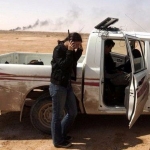Remembering Japan's tsunami disaster
Tokyo - In March 2011, one of the strongest earthquakes ever recorded struck off Japan’s northeast coast, causing a deadly tsunami that triggered a nuclear meltdown.
AFP’s Tokyo bureau mobilised quickly, and journalists have spent years reporting from the affected Tohoku region. A decade after the disaster, which left around 18,500 people dead or missing, AFP journalists returned to the area to report a series of stories ahead of the anniversary.
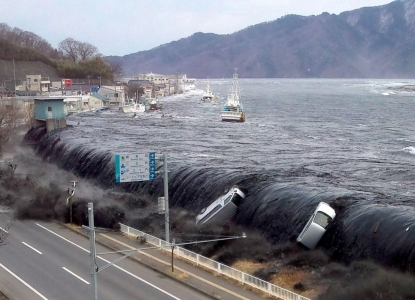 Picture taken by a Miyako City official on March 11, 2011 (AFP / Jiji Press)
Picture taken by a Miyako City official on March 11, 2011 (AFP / Jiji Press)Four of the journalists involved in that coverage also reported from Tohoku for AFP in the immediate aftermath of the disaster -- text reporters Shingo Ito and Hiroshi Hiyama, photographer Kazuhiro Nogi, and video journalist Harumi Ozawa, who was a text reporter in 2011. Here they reflect on their experiences covering the disaster and returning to the region 10 years later.
‘As if God drew a line’
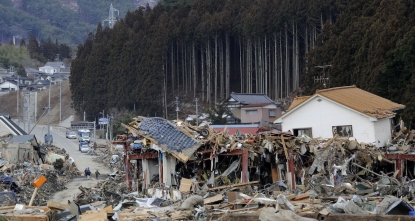 Rikuzentakata, Iwate prefecture, on March 17, 2011 (AFP / Kazuhiro Nogi)
Rikuzentakata, Iwate prefecture, on March 17, 2011 (AFP / Kazuhiro Nogi)Nogi was on a train in Tokyo when the 9.0-magnitude earthquake hit at 2.46pm, producing “a violent jolt like I’d never felt before.”
“I got off the train to escape, but the quake was so strong that I couldn’t walk straight,” he recalled. When he got outside, he watched skyscrapers swaying in unison as the tremors continued. Nogi headed with a team straight towards the affected area, arriving the following day in the area of Minamisoma in Fukushima prefecture.
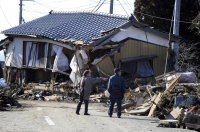
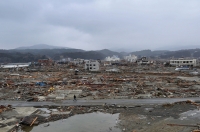

“A desolate landscape submerged in ocean water spread before our eyes,” he said. Hiyama was with him, still dressed in his pinstriped suit and leather shoes, having had no time to change before heading out.
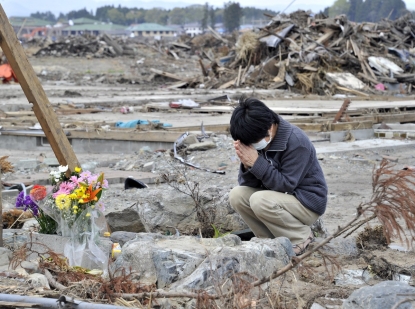 Prayer in Minamisoma (Fukushima prefecture), May 2, 2011. (AFP / Yoshikazu Tsuno)
Prayer in Minamisoma (Fukushima prefecture), May 2, 2011. (AFP / Yoshikazu Tsuno)
When the team reached the Minamisoma city hall, everything seemed fine, but as they drove towards the coast, “the town suddenly ended,” Hiyama said. “It was as if God drew a line and decided to destroy everything east of it with water.”
The Line – the point reached by the towering tsunami waves – struck others reporting from the region. Ito recalls the feeling of driving from normal life into another world. “Mud blanketed everything. Roads were swamped, bridges toppled, seawalls knocked down. Ocean gusts blew dust into the air... the shape of communities no longer matched what was on the map,” he said.
“I felt that ‘the Line’ was the divider between heaven and hell.”
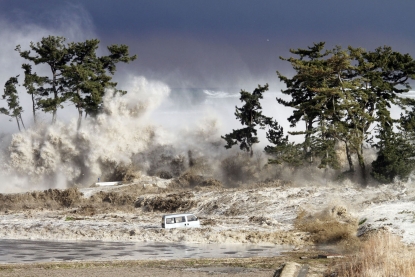 Tsunami waves hitting the coast of Minamisoma in Fukushima prefecture. (AFP / JIJI PRESS / Sadatsugu Tomizawa)
Tsunami waves hitting the coast of Minamisoma in Fukushima prefecture. (AFP / JIJI PRESS / Sadatsugu Tomizawa)
Ozawa had been in the region a year before the disaster, when people were told to evacuate because an earthquake in Chile could cause a tsunami.
At that time, she met a woman at a school gymnasium shelter in Miyagi’s Minamisanriku who had lost her son five decades ago while fleeing tsunami waves. “She thought she made sure to wrap her baby tightly on her back, but the little boy must have slipped from her kimono and she found nothing on her back when she finally reached dry land,” Ozawa said.
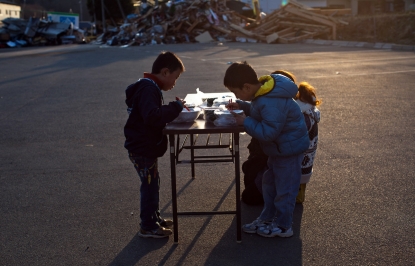 Teru Sutou (L), 8 and his brother Ren, 9, eat a distributed hot stew and rice at a parking lot in Minamisanriku, Miyagi prefecture on April 12, 2011. (AFP / Yasuyoshi Chiba)
Teru Sutou (L), 8 and his brother Ren, 9, eat a distributed hot stew and rice at a parking lot in Minamisanriku, Miyagi prefecture on April 12, 2011. (AFP / Yasuyoshi Chiba)When Ozawa returned to Minamisanriku in April 2011, she found the town had been washed away and remembered the woman she had met. “I heard the water reached the top of the hill where the school was. The gymnasium barely survived.”
Radiation fears
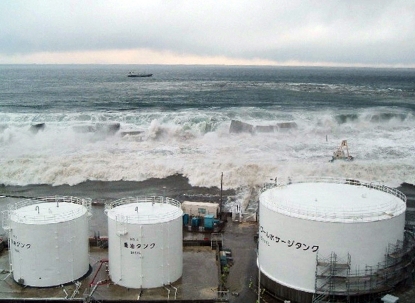 (AFP / Handout)
(AFP / Handout)
Hiyama and Nogi were on the side of a road on March 12 when a firefighter pulled up. “The nuclear plant went,” the man announced, mimicking an explosion with his hand. The team rushed into their car and drove to a rest area around 20 kilometres from the Fukushima Daiichi plant. A television was showing the news of the developing crisis.
“It’s hard to fathom the situation when a TV anchor tells you that you are in the midst of a growing nuclear accident,” Hiyama said. “I checked the map repeatedly to make sure that I was outside the 20 kilometre evacuation radius. I thought about my pregnant wife and our two-year-old son.”
The weight of the radiation disaster didn’t hit Ito fully until he visited a farm in a no-go zone, where cows were dying of illness and starvation. “I felt invisible fear for the first time. Something we can neither see nor smell, with only the alarm of a Geiger counter telling of the danger,” he said.
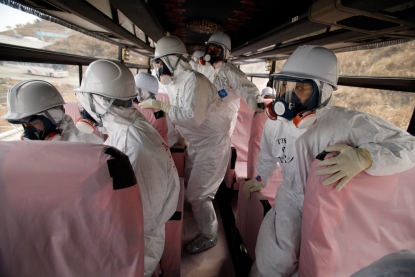 Officials from Tokyo Electric Power Co. (TEPCO) and members of media look at tsunami-crippled Fukushima Daiichi nuclear power plant from a bus window on February 20, 2012. (AFP / Issei Kato)
Officials from Tokyo Electric Power Co. (TEPCO) and members of media look at tsunami-crippled Fukushima Daiichi nuclear power plant from a bus window on February 20, 2012. (AFP / Issei Kato)Unbearable loss
In April 2011, Ozawa met a man sitting on a rock brought ashore by the tsunami, gazing out to sea. She approached him but he “looked as if he had not heard me or even noticed I was there.” A relative explained the man had lost his daughter-in-law and three grandchildren.
“I still remember the scene of the blue sky and ocean and the heart-trembling feeling I had when I tried to speak with this old man but couldn’t,” she said. Approaching those who had suffered enormous loss left reporters feeling conflicted and guilty.
 A man comforts a woman as she cries in front of her damaged home in the town of Watari in Miyagi prefecture on March 14, 2011 (AFP / Jiji Press)
A man comforts a woman as she cries in front of her damaged home in the town of Watari in Miyagi prefecture on March 14, 2011 (AFP / Jiji Press)Ito one day came across a woman crying on her knees before the body of a family member lying on the ground covered with a blanket. “I should have spoken to her... I just stood next to her for a long time, holding my tape recorder in my trembling hand,” he said. “That’s the hardest part of our job.”
A sense of trauma
Nogi battled guilt as he covered the disaster -- “after all, I was making a living by taking photographs of those who had suffered,” he said. “But it is also true that the empathy and objectivity that I learned during this time and the way of turning on and off the switch of my emotions is something I have been able to apply in subsequent natural disasters.”
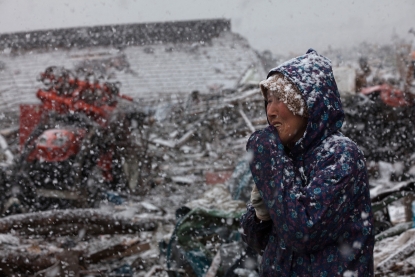 Yukiko Kometa, 74 ans, face à sa maison détruite par le séisme suivi du tsunami, le 27 mars 2011 à Noda, dans la préfecture d'Iwate (AFP / Yasuyoshi Chiba)
Yukiko Kometa, 74 ans, face à sa maison détruite par le séisme suivi du tsunami, le 27 mars 2011 à Noda, dans la préfecture d'Iwate (AFP / Yasuyoshi Chiba)He was struck by a hospital worker who was explaining the difficulty of treating patients with sand in their lungs from the tsunami waves. He learned the man had not yet been able to contact his own family to confirm they were safe.
“He had to prioritise his work... but was filled with worries and concerns,” Nogi said. “I thought ‘what about me?’ ‘Would I be able to work more than protect my own family?’”
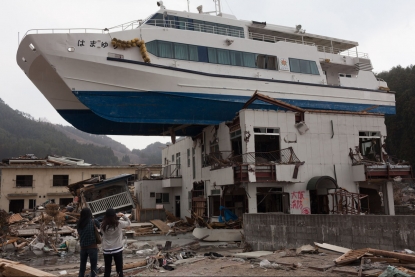 Otsuchi, Iwate prefecture on April 16, 2011. (AFP / Yasuyoshi Chiba)
Otsuchi, Iwate prefecture on April 16, 2011. (AFP / Yasuyoshi Chiba)
Ito found he quickly grew used to the abnormal scenes of boats washed inland onto rooftops “but death was a different story.” “I still can’t forget the smell and the red flags flying in the sea breeze, indicating the locations of recovered bodies.”
“On our way back to the hotel one evening, all of us in the car were silent, partially because we were exhausted and partially because we were suffering a sense of trauma, or at least I was,” he said. “I felt almost like screaming out. At night, a horrible scene flashed back to me, and I woke up drenched in sweat on the hotel bed.”
Collective sorrow
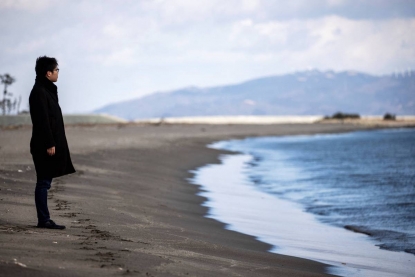 In this picture taken on February 8, 2021, Nayuta Ganbe, who survived Japan's devastating 2011 tsunami by taking shelter at his school, poses as he looks at the Pacific Ocean in Higashimatsushima, Miyagi prefecture. (AFP / Behrouz Mehri)
In this picture taken on February 8, 2021, Nayuta Ganbe, who survived Japan's devastating 2011 tsunami by taking shelter at his school, poses as he looks at the Pacific Ocean in Higashimatsushima, Miyagi prefecture. (AFP / Behrouz Mehri)AFP journalists visit the Tohoku region regularly, and Ozawa finds each trip emotional, including her most recent to Fukushima this year.
“For the first time ever in my career, I couldn’t hold back my tears,” she said. “An 83-year-old man told us how he lost his wife in the gushing tsunami water. No matter how tightly he held her in his arms, her body slipped out and she was taken away from him.”
The man couldn't reach her body because of radiation, and her remains decomposed before they were finally recovered. A police officer later brought a photo of her body, which looked nothing like the wife in his memory. The man was so horrified, he asked the police officer to burn the photo on the spot, which he did.
 Ofunato on March 14, 2011 and on March 4, 2021 (AFP / Toshifumi Kitamura)
Ofunato on March 14, 2011 and on March 4, 2021 (AFP / Toshifumi Kitamura)
“I had successfully held back my tears during many previous interviews, Ozawa said. “But not this time. Thankfully all the tears fell inside my mask”.
Returning this year, Hiyama felt the contrast between the region's recovery, and its memories. “The business of living continues… Some areas felt like living inside giant construction sites,” he said. “All those new structures stand on ground where nearly 20,000 people died or remain missing. It’s like the collective sorrow and misery of local families are also buried deep, hidden under the facade of the new Tohoku.”
A place of joy
AFP journalists will continue to report from Tohoku, and Ito is looking forward to following up with Reverend Sato, who he has interviewed over the years since he was forced to leave behind his churches in radiation-hit areas. After the disaster, Sato dreamed of building a new church, and he has, and many of his original flock now worship there.
Now he hopes to returning to his original church after evacuation orders are lifted, perhaps next year.
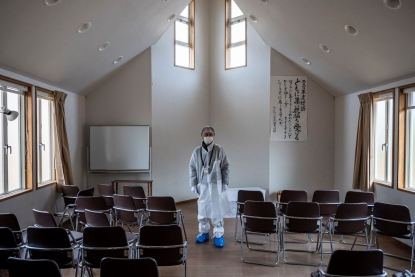 Akira Sato at the abandoned chapel of old Fukushima First Bible Baptist Church inside the exclusion zone in Tomioka (AFP / Philip Fong)
Akira Sato at the abandoned chapel of old Fukushima First Bible Baptist Church inside the exclusion zone in Tomioka (AFP / Philip Fong)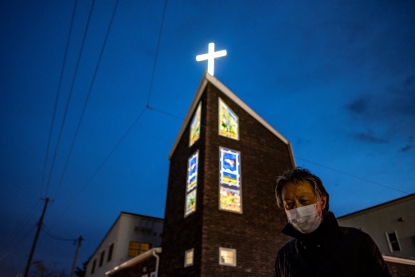 Akira Sato stands in front of the new Fukushima First Bible Baptist Church in the Izumi district of Iwaki, Fukushima prefecture (AFP / Philip Fong)
Akira Sato stands in front of the new Fukushima First Bible Baptist Church in the Izumi district of Iwaki, Fukushima prefecture (AFP / Philip Fong)
“We have many sad stories from Fukushima, but his story is encouraging,” Ito said. “I hope to see his next chapter in the future.” Hiyama points out there is more to Tohoku than the 2011 disaster, including its natural beauty and famed produce. “The ocean there, if you find the right spot, will take your breath away,” he said.
“The area is also proof that humans are resilient. Tohoku is not all about sadness. It’s also a place of joy.”
Written by Sara Hussein in Tokyo. Edited by Michaëla Cancela-Kieffer in Paris


